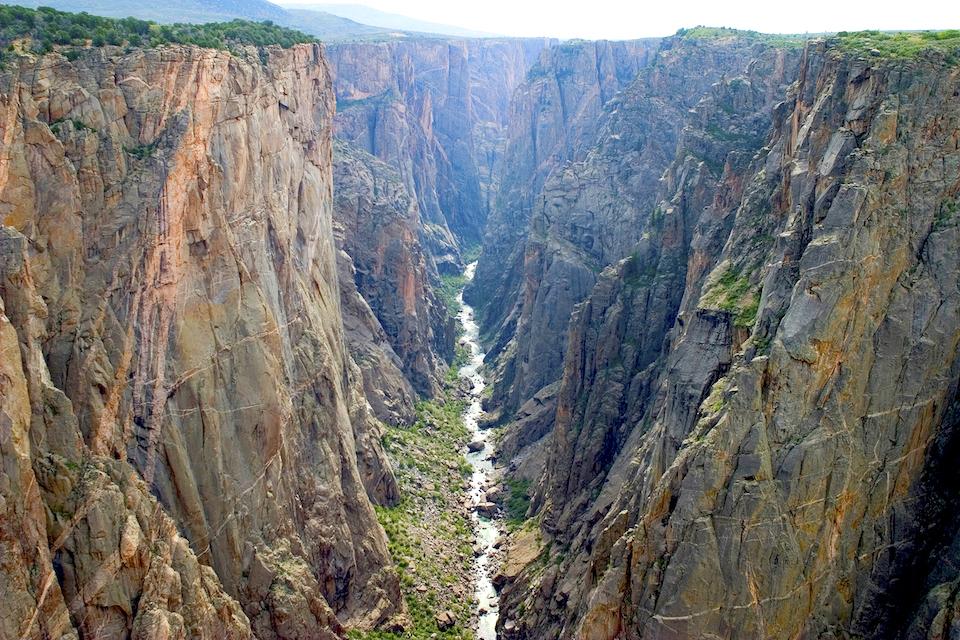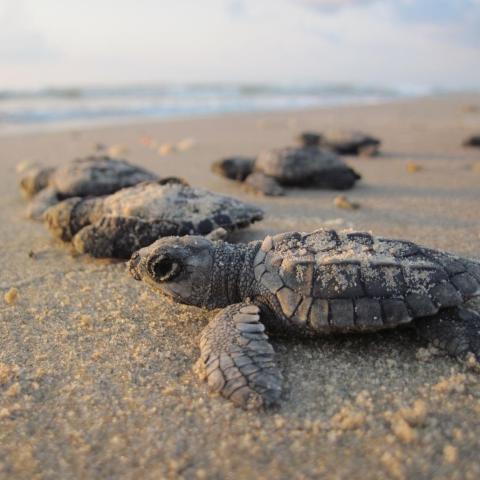
NPCA staff fear the repeal of the 2015 Clean Water Rule could harm many park's waters, including those at Black Canyon of the Gunnison National Park/NPS, Lisa Lynch file
Think of threats to a national park, and clean water doesn't immediately come to mind, does it? Many view parks as offering some of the most pristine water around. After all, park boundaries are viewed as protection for natural resources, and leafy forests protect watersheds, which in turn filter rainwater.
So when word came that the Trump administration had repealed a 2015 rule that was viewed as a key to protecting clean water from pollutants, you probably didn't think it would impact your favorite national park. But it just might, according to the National Parks Conservation Association.
NPCA's take on the repeal of the 2015 Clean Water Rule is that it, along with the administration's pro-industry stance in general, stands to threaten "drinking water for communities and national park waterways across the country."
“Today’s reckless move by the administration erases years of significant improvements to the protection of our nation’s waterways," Theresa Pierno, the advocacy group's president and CEO, said last week. "Clean, safe water is a human right, and shouldn’t be sacrificed for the benefit of industry. It is essential to our national parks, the more than 300 million people who visit them every year, and the communities that surround them. These water protection rollbacks are coming at a time when we’re seeing toxic algae plague our waterways, and communities still struggling in the aftermath of the Flint, Michigan and Toledo, Ohio water crises. It’s clear that we need more clean water protections, not less.”
Also opposing the repeal was the Izaak Walton League, which maintained the repeal "is wholly unsupported by science, can’t be squared with the clear intent of the Clean Water Act, and fails the common-sense test.”
Environmental Protection Agency officials say the repeal ends "the previous administration’s overreach in the federal regulation of U.S. waters."
“Before this final rule, a patchwork of regulations existed across the country as a result of various judicial decisions enjoining the 2015 Rule," said R.D. James, th assistant secretary of the Army for Civil Works. "This final rule reestablishes national consistency across the country by returning all jurisdictions to the longstanding regulatory framework that existed prior to the 2015 Rule, which is more familiar to the agencies, States, Tribes, local governments, regulated entities, and the public while the agencies engage in a second rulemaking to revise the definition of ‘waters of the United States.’”
Back at NPCA, staff maintain that "water quality is 'impaired' in two-thirds" -- 237 -- of national parks that have water bodies in them.
"Failing to protect the small streams and wetlands covered in the original rule will contribute to the potential pollution washing downstream," NPCA said in a December 2018 blog post. "Wetlands, for example, filter water, removing pollutants and providing opportunities to recharge groundwater. The trickle-down effect on water quality could be dramatic with potential impacts on drinking water, swimming, paddling and camping, not to mention wildlife habitat."
So, which parks could be impacted?
* Acadia National Park
"Six lakes and ponds in the park are drinking water sources for nearby communities. Yet park waters have tested at high concentrations of fecal indicator bacteria, suggesting that dangerous pathogens are likely in the water," says NPCA."Sewage overflows triggered by heavy rains are the primary source of these bacteria, although pet and wildlife waste may also contribute to the problem."
* Antietam National Battlefield
"Many of the water quality issues at Antietam are caused by runoff from urban and agricultural areas. This runoff transports pollutants into Antietam Creek, which then empties into the Potomac River, a source of drinking water for millions of people," NPCA maintains. "These pollutants include nitrates, phosphorus, chlorides, sulfates, sediments, and human and animal waste. Failing septic systems, municipal sewage discharges, pet waste, livestock waste and manure fertilizers are all sources of this pollution."
* Biscayne National Park
"...some fish species have tested positive for unsafe levels of mercury. Park waters also experience low levels of dissolved oxygen caused by large algal blooms, which occur due to excess quantities of nutrients in the water," the park advocacy group says.
* Black Canyon of the Gunnison National Park
The park's watershed contains naturally occurring levels of selenium, but NPCA said "irrigation substantially increases the amount of selenium that gets dissolved and washed in the waterways. This irrigation is mostly agricultural, but other sources contribute to the problem. The selenium causes reproductive issues in fish and the birds that feed on them."
* Cuyahoga Valley National Park
While the Cuyahoga River is no longer in danger of catching fire, as it did in 1969, it occasionally shows "high concentrations of E. coli and other fecal bacteria. Stormwater from heavy rains overwhelms wastewater treatment plants, resulting in overflows of untreated sewage," says NPCA.
You can find more parks that NPCA is concerned about at this page.
"Many people assume that because a park is protected, its waters are pure, but maintaining the health of wetlands, rivers, lakes and streams requires careful management both within and beyond park borders. The original Clean Water Rule provided a helpful roadmap for people charged with preserving these waters," say NPCA staff.




 Support Essential Coverage of Essential Places
Support Essential Coverage of Essential Places







Comments
It would appear these parks' waters are already contaminated even with the the rule in place. Obviously the rule wasn't working. It would be helpful to provide some specifics on how the removal of the rule would make matters worse.
https://www.craterlakeinstitute.com/crater-lake-new-archives/1975-2/1975...
44 Years ago, Crater Lake's supposed clean drinking water source was contaminated by sewage from a Rim Village sewage line buried and placed down slope above the surface spring which was the Park'a primary water source: all permitted via grossly incompetent CRLA NPS Managers, both the Superintendent and Maintenance Chief with the co-operation of Denver NPS Service Center !
Prior to this July 1975 Incident, Crater Lake Lodge sewage was dumped into a poorly located inadequate septic system less than 100 feet from the Caldera Rim ca. 900 feet above Crater Lake's pristine waters. Hikers beginning the Garfield Pk. Trail were greeted by the septic's raw sewage stench which overflowed on the surface: all from the older Lodge's restroom toilets.
Visit Doug Larson Interview:
http://digitallib.oit.edu/digital/collection/craterlake/id/320/
Prior to this Incident, corruption within The NPS prevented any scientifically approved protocol to monitor drinking water purity.
Following this CRLA NPS drinking water incident, the better water source selected was Anna Spring, at an 6000 n ft. elevation
Today, CRLA's Water Source is a deep well located on the Cascade Crest above Anna Spring ca. one mile via the west road to avoid a Water Rights Legal Issue with The Klamath Tribes for east side water.
https://www.craterlakeinstitute.com/crater-lake-new-archives/1975-2/1975...
https://www.nrdc.org/experts/jon-devine/updated-trump-budget-would-still...
https://www.scientificamerican.com/article/trump-rsquo-s-order-may-foul-...
Come on, EC: I try to read your postings with some respect, but now you're just trolling. Some houses still burn down: does that mean that obviously building codes aren't working? After all, how do we know that removing building codes might make things worse? Cars crash: does that mean we should remove traffic laws that "obviously aren't working"?
Water quality is a matter of degree, a continuous scale. There can be relatively pristine water, or trace levels of contaminants still below regulatory thresholds, or concentrations just above attainment of regulatory thresholds ("impaired"), on up to much much worse concentrations of toxins and contaminants. Even if rules (that in this case haven't gone into effect in most states) don't get all waters below that regulatory threshold, they do reduce the contaminant loads, or they would if enforced.
The specific 2015 rule being rolled back has to do with how far the clean water act extends as "Waters of the US". The issue is not that you can dump things directly into big rivers or streams. The issue in this rule is whether you can dump contaminants or fill into ponds and intermittent streams. The 2015 rule said not if the actions on those wetlands would affect water quality in the perennial streams and rivers that are WOTUS: "direct nexus" and such. The repeal says that while you still can't discharge directly into the rivers, you are free to do whatever in wetlands on your property, even if your actions directly contaminate rivers and streams. As long as the contaminant transport has a component via groundwater, or intermittent surface flows, a landowner higher in the watershed can put E. coli, metals, nutrient runoff, or pretty much anything into the downstream waters. A related case of Maui wastewater has reached the US Supreme Court. The wastewater facility injects wastewater into the ground adjacent to the ocean, and the contaminants percolate rapidly through the groundwater to the ocean. Direct dumping into the ocean would be illegal. Is injection into the ground instead of running a pipe enough to make the contamination legal, outside of the reach of US law? If so, can a pulp mill just build a gravel berm, dump their effluent on their side of the berm instead of running a pipe all the way to the river, and have a free pass on contaminating the river, because the outfall pipe was replaced by percolation through gravel? Call me a conservative or even an originalist, but a rule stating that what you do on your land is fine unless it affects or contaminates (permanent, navigable) waters of the US off of your land seems a pretty direct implementation of the wording of the law.
While many western parks are tops of watersheds (tops of mountains: North Cascade, Olympic, Lassen, Crater Lake, Glacier, Yellowstone, Rocky Mountain, etc.), the vast majority of parks are not. What goes on in the parks themselves is driven by the organic act "unimpaired for the enjoyment of future generations", so for the most part waters don't get degraded within parks. But the waters that flow into and through parks carry contaminant loads from upstream activities and land use. _That_ is what the rollback of the 2015 WOTUS rule is about.
And to reiterate: the WOTUS rule is stayed in most states, and has barely gone into effect in the others, so it still hasn't been "in place" in any meaningful sense of teh term, and certainly has had no chance to affect water quality in parks yet.
Tomp2 - Trolling? Hardly, Just pointing out how silly these chicken little articles are. Always some mythical prediction of disastrous results that seldom happen and ten years down the road the failed prediction is replaced with some new catastrophic prediction. The article, or those quoted in it, made specific claims about specific parks. There is no evidence the implementation of the rule improved the water at any of those parks and no evidence that the removal of the rules will hurt the water quality. WOTUS is not going to have any impact on ecoli and fecal matter in the Cuyahoga and WOTUS isn't even enforced in Florida. How does reversing a rule that isn't enforced in the first place going to hurt Biscayne? WOTUS was an overreach that declared mud puddles, seasonal ditches and 100 year flood plains as navigable waters creating substantial, unnecessary and ineffective regulatory and financial burdens on farmers and other industries.
How timely - released yesterday and exactly do my point.
https://cei.org/blog/wrong-again-50-years-failed-eco-pocalyptic-predictions
AH, yes, a link to a far-right website filled with propaganda tells us that ec is trying hard to fool the rest of us.
Anon - right leaning perhaps but that is moot. As usually, when one can't dispute the facts presented, you go after the source. Tell us, and show us, which one of the citations are wrong.
A website that tries to use a bunch of ultra-left propaganda to "counter" ultra-right propaganda is not science.